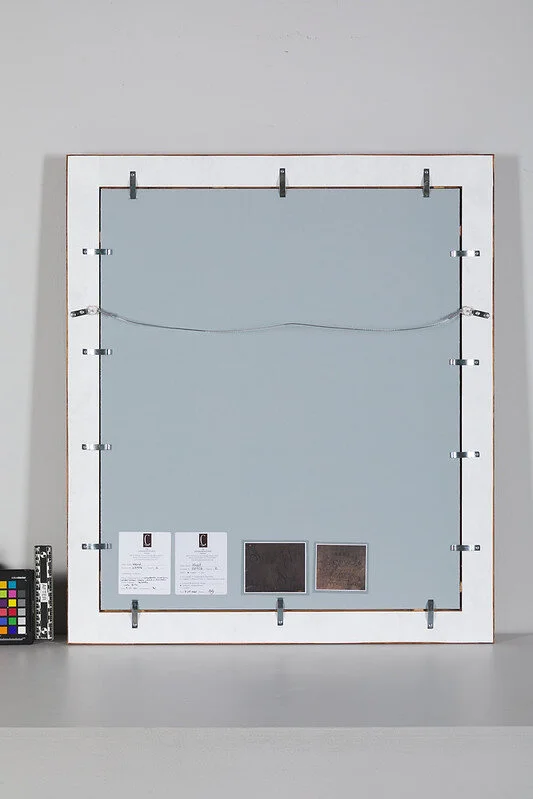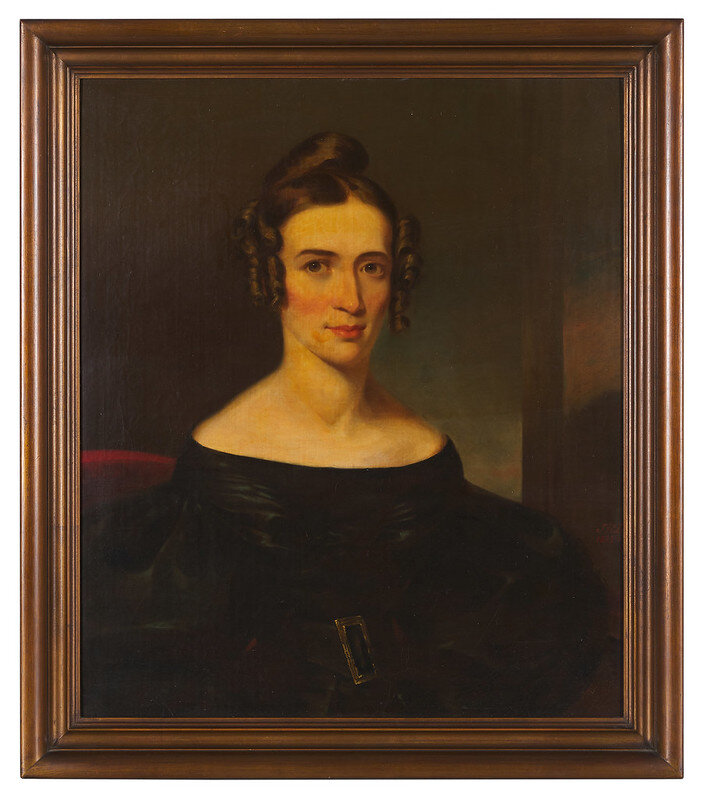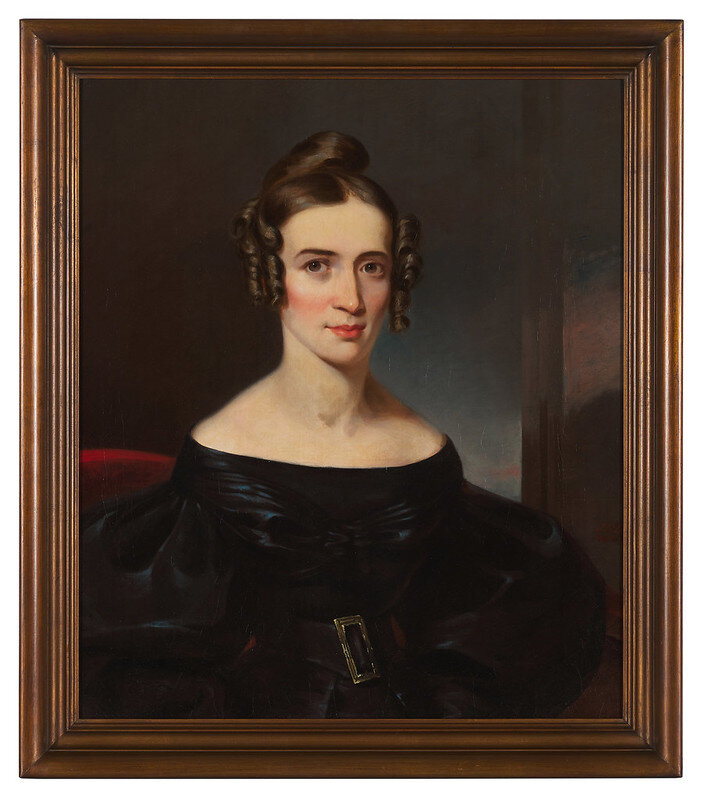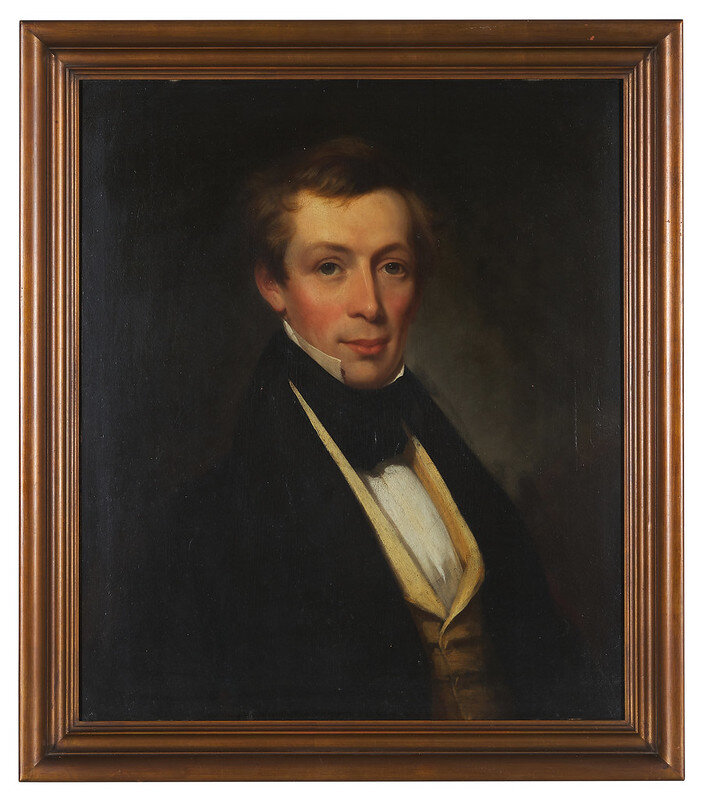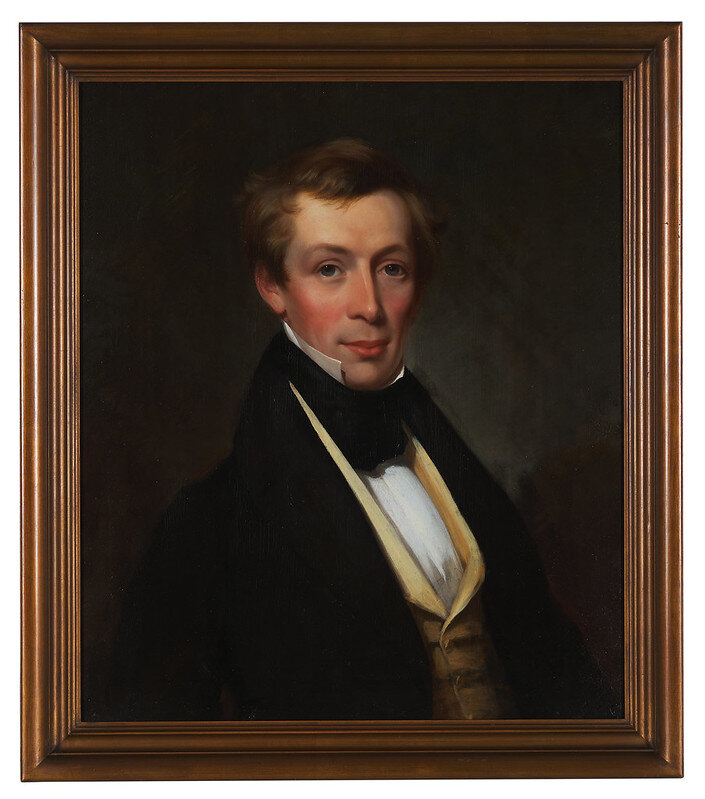If portraits could speak, we're certain we'd be captivated by what Mr. and Mrs. Robert Stockton had to say. This distinguished pair of 185-year-old oil pendant portraits came to us from a private client's collection with a fascinating family history.
Mrs. Stockton before treatment.
Mr. Stockton before treatment.
Each portrait, though part of a pair, presented its own unique challenge. Mrs. Stockton's portrait had at least two prior extensive restoration campaigns that left her with large areas of discolored and heavy-handed overpaint. In addition to the overpaint, the portrait appeared to have been removed from a stretcher, with the tacking edges cut off and glued to a thick paper board, likely to address raised cracking in the paint layer. Mr. Stockton's portrait also seems to have been treated in the past, but by a far more delicate hand. Both paintings exhibited cracks in the paint layer and abrasions along the edges, where the frame was in contact with the paint layer. The varnish layer of both portraits had yellowed with age, though Mrs. Stockton's portrait's varnish was so thick that it hid all the texture of the canvas weave and the brush strokes. The portrait also had a heavy grime and soot layer. The frames also had a moderate layer of particulates, abrasions, and scratches, with some losses.
The yellowed varnish is noticeable during it’s removal.
Rebecca Vodehnal, Associate Painting Conservator, set to work on Mrs. Stockton's portrait. The portrait was first surface cleaned to remove a light grime layer, and the reverse cleaned using a soft brush and vacuum. Next, the heavy varnish layer and the discolored overpaint were removed to the extent safely possible, resulting in a particularly dramatic visual change in the background as it changed from a shade of brown to red and purple.
Further into the treatment process.
A varnish coat was used to saturate the paint later and then began the long inpainting process. Unfortunately, not all of the old overpaint could be safely removed, especially in the face. The old overpaint appeared to be oil paint, the same medium as the original painting. Removing oil paint from oil paint is very tricky since they are the same medium and are sensitive in the same solvents.
Not all of the old overpaint was able to be removed.
Modern conservation methods focus on being reversible if further work is needed in the future, meaning oil paint is never used to inpaint on oil paint. Reversibility is crucial in conservation, and our conservators always carry out treatments using the least invasive methods possible. Once inpainting was finished using Gamblin Conservation Colors, a final coat of varnish was applied to integrate the surface gloss.
After treatment.
Treatment for the portrait of Mr. Stockton, however, was more straightforward. The painting was surface cleaned, the varnish was removed as safely possible, the painting was revarnished and minimal inpainting was carried out.
During treatment.
After treatment.
Meanwhile, the frames were in the capable hands of our Custom Framing and Fabrication department. The surfaces were cleaned on all sides, and the scratches were retouched where necessary to emulate the existing finish. The backing papers were removed, and the provenance was carefully encapsulated in protective Mylar. Finally, the pieces were reinstalled in the frame, with an acid-free Coroplast backing board attached to the reverse to provide additional protection, along with the newly encapsulated provenance.
Before treatment:
After treatment:
After treatment.
These portraits are beautiful to look at and offer a unique family history that we thoroughly enjoyed learning about. The man in the portrait, Mr. Robert Clark Stockton, was the son of Rev. Joseph A Stockton (b. Feb. 25, 1775 – Oct. 29,1832), who published the "Western Calculator" and "Western Spelling Book" – both which were used extensively in schools. He was also one of the Western Theological Seminary founders, now known as the Pittsburgh Theological Seminary. Abraham Lincoln personally thanked Mr. Robert Clark Stockton's mother, Esther (b. March 29, 1778 - d. April 13, 1868) in a letter dated Jan. 8, 1864 for knitting 300 pairs of stockings for Union soldiers.
Abraham Lincoln’s letter to Mrs. Stockton.
Mr. Robert Clark Stockton (b. June 11, 1804 - April 28, 1868) was one of eight children. As an adult he joined the printing firm of Eichbaun and Johnson, later becoming Eichbaum and Stockton in 1824. They printed, published and bound books and had the first power press run by steam west of the Alleghanies. They printed both of the books his father, Rev. Joseph, had written. Mr. Robert Stockton married his wife, Martha C. Little, the woman in the second portrait, on October 17, 1830. They had six children, Joseph, John, William, Eliza, Mary, and Esther. The portraits were given to his daughter Esther from Robert, and had since been passed down through generations.
Mrs. Stockton after treatment.
Mr. Stockton after treatment.
We are truly grateful to have played a role in preserving the legacy of such a rich family history. We enjoy learning the backstories of each family heirloom that enters our doors, and take pride in the trust clients put in us to bring their pieces back to life.
Sources:
https://commons.wikimedia.org/wiki/File:Esther_Stockton_letter.jpg













